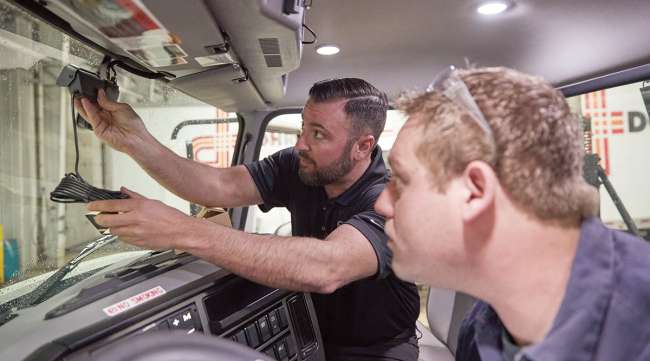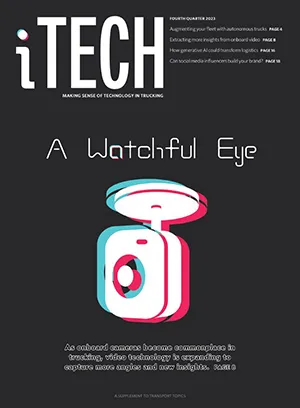Transparency, Privacy Features Help Boost Camera Acceptance

[Find the latest in trucking technology: Explore this quarter's issue of iTECH]
Video-based safety systems are helping fleets prevent crashes and exonerate drivers, but successful deployment of this technology continues to hinge on driver acceptance.
Fleets and technology providers said they’re finding ways to gain drivers’ support and protect their privacy.
“As long as you’re upfront with the drivers and building the trust with them on the true use and benefit of the systems, nine times out of 10, they are bought in,” said Lynn Berning, risk and compliance manager for Tucker Freight Lines, based in Dubuque, Iowa.
Tucker Freight Lines has deployed Isaac Instruments’ road-facing cameras across its entire fleet and driver-facing cameras in slip-seating situations and as part of its corrective action plans. Within months of installing cameras in 2018, the fleet used video to exonerate a driver at the scene.
“Since then, we’ve been able to show other drivers that the cameras are for our benefit and offer them a layer of protection,” Berning said.

Q4 iTECH
►Cameras Provide Operational Value
►Gaining Camera Acceptance
►Transforming Logistics With AI
►Q and A: John Reed, Aim Transportation Solutions
►Dysart: Using Social Media Influencers for Promotion
►Clevenger: Autonomous Trucks as a Supplement, Not a Substitution
Explore the Issue!
Jean-Sébastien Bouchard, Isaac Instruments’ co-founder and executive vice president of sales, said having video on the scene after a crash can change the way the officer writes that report.
“The quicker the fleet gets access to that video and shows it to the officer, the better off they are,” he said.
Rajesh Rudraradhya, chief technology officer at video telematics firm Lytx, said an exoneration is often the turning point for driver acceptance.
“Then, the driver becomes the voice of the product, and they start to advocate for it,” he said. “The other example is when they get the timely alerts where they know they would have gotten into a collision without them.”
Having drivers share their stories helps fleets organically grow support for video technology, said Ingo Wiegand, vice president of product at Samsara.
Samsara has identified several key elements of gaining driver support, including being transparent with them about what the cameras do, how they work and why the fleet is using them.
Rio Valley Biofuel Transport has Isaac’s forward- and inward-facing cameras in every vehicle and is upfront with drivers about how the company uses the cameras for safety.
“We really value and honor their privacy,” said Maridee Jenkins, compliance and safety lead for the fleet. “We’re not trying to spy on our drivers. A recording is only triggered by a critical event. It isn’t streaming where we can flip it on and watch them.”
Jenkins said the company sees video as a way to protect drivers.
“Our CEO said that sending out our drivers without those two cameras would be like sending out our hazmat drivers without their [personal protective equipment],” she said.

Schedler
Mark Schedler, senior editor for transport at regulatory compliance company J.J. Keller & Associates, advises fleets to share statistics with drivers.
“Drivers need to see the value in a dashcam coaching program, including driver-facing cameras, if used,” he said. “Based on [Department of Transportation] crash statistics, the passenger car driver is at fault in at least 70% of fatal truck-passenger vehicle-involved crashes.”
Schedler said a study by the American Transportation Research Institute found that approval of driver-facing cameras was 87% higher when carriers used the video footage for safety programs, driver coaching and training than when there was no proactive safety use.
The most effective coaching is positive reinforcement instead of negative criticism.
“The best tool is finding videos where the driver performs in a manner that is the definition of being a professional driver and acts correctly and then that video is used as an educational tool to show drivers how they should react in certain situations,” said Matthew Carter, manager of sales engineering at transportation technology supplier Trimble.

Gupta
For driver coaching to work well, the video data must be accurate, said Abhishek Gupta, vice president of product at Motive.
“Drivers have to trust it,” he said, adding that he recommends fleets roll out dashcams gradually and spend time educating drivers on the benefits.
It is also important for companies to avoid excessive coaching for minor incidents and prioritize the most important behaviors, such as distracted or drowsy driving and seat belt use, J.J. Keller’s Schedler said.
He added that a bonus program can be a powerful tool in gaining driver acceptance.
“Money in a driver’s paycheck and recognition tied to desired changes are often effective,” he said.
A privacy policy can also help assuage driver concerns. Many camera systems use a privacy mode feature that turns off the inward-facing cameras and can be enabled by the driver when stopped.
“Subsequently, the privacy mode is automatically canceled when the vehicle starts moving again, thus automatically enabling the driver-facing safety features,” Trimble’s Carter said.
How can you start your own trucking business? We introduce you to a seasoned trucking business owner who transformed a simple idea into a thriving enterprise. Tune in above or by going to RoadSigns.ttnews.com.
Gupta said Motive’s cameras can be turned off automatically when drivers are resting.
“We feel the cameras should work for them when they’re on the job, not when they’re treating the truck as their home,” he said.
Fleets can also configure parameters around recordings, Samsara’s Weigand said, such as only turning them on when the vehicle is moving at a certain speed.
Rudraradhya of Lytx said AI can capture and classify driver behavior without recording video. “We’ve made it configurable for turning video on and off, blurring faces for nondrivers in the cab or turning off audio,” he said. “We have focused on privacy and that has helped with adoption.”
Cascade Environmental, a private fleet operator based in Bothell, Wash., uses cameras from Motive but does not record in-cab audio to help protect drivers’ privacy, said Alex Amort, the company’s vice president of compliance.
Despite concerns over attracting and retaining drivers, some fleets have seen an increase in driver retention, even with driver-facing cameras.
“We studied 30,000 drivers across many of our customers and found that dual-facing dashcams don’t affect driver retention,” Motive’s Gupta said. “Some fleets saw a 3% increase in driver retention.”
Safety technology also can show drivers that the fleet cares about their safety.
“The risk of being on the road is undeniable, and everyone wants to be good at their job. Feeling like you are improving and seeing the incident statistic going down shows that you’re winning as a team and drives cohesion,” Samsara’s Wiegand said. “It creates a more engaging work environment.”
Want more news? Listen to today's daily briefing below or go here for more info:





